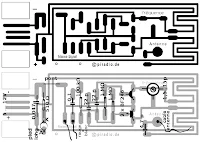Here is the specification of the transmitter:
1. No. of stage: 4
2. Frequency of operation: About 100MHz
3. Antenna type: Folded 300 ohms dipole.
4. Range obtained in free space: Up to 4km with dipole antenna 30 feet above ground level. More range with yagi antenna.
Fig: Circuit diagram of the Transmitter
Brief Description:
The transmitter is built on a Printed Circuit Board. This board uses track inductor for L1, L2 and part of L3. The section built around Q1 is the oscillator section. Oscillation frequency is determined by L1, C4 & C5 which forms the tank. Actually C5 is the feedback capacitor. This is required to sustain oscillation. This also influence the operation of tank formed by L1 & C4. Modulation is directly applied to the base of Q1 via C2. A microphone is connected here to serve this purpose. You can alternately feed direct audio here after disconnecting the microphone biasing resistor R1. Q2, Q3 & Q4 gradually raises the output power up to the desired level.
As most of the inductors are PCB etched, there is practically very little frequency drift provided you use a highly regulated and ripple free power supply.
RF output from the transmitter is taken from the junction of C11 & C12. This is unbalanced output of around 75 ohms impedance. But a folded dipole is a balanced type antenna of around 300 ohms impedance. So we need to use a 'BALanced to UNbalanced transformer' or 'BALUN'. A 1:4 type BALUN is employed here for this purpose. Antenna connection is taken from this BALUN via a 300 ohms flat parallel feeder cable commonly used in television to receive terrestrial broadcast. No coaxia is used to feed antenna. This saves cost. Also a parallel feeder cable provides much less signal loss compared to a coaxial.
Click 'Read More" to see details with pictures
Design of BALUN The BALUN is made using a two-hole binocular ferrite bead as shown above. You need to use parallel insulated twin wire to construct this. This wire is commonly used to wind TV BALUN transformer. If you want to get rid of this, then buy a ready-made TV BALUN that is generally used at the back of your television set for interfacing with feeder wire. If you prefer to build this yourself, the circuit diagram is given above. You need to carefully construct it keeping in mind about the 'sense' & 'direction' of turns. See there are four coils. Two coils in the upper section, which are red and blue, required to be wound on left side of the BALUN and the remaining two (blue & red) in the lower half to be wound on right side. Connection marked 'A' and 'B' at the left side of the circuit is reqired to be connected to the PCB at the shown point. As dipole antenna is balanced type, so you need not to worry about its connection. PCB design detailsThe transmitter is built on a single sided PCB. As mentioned earlier, this PCB has a number of etched inductors. For this reason, you need to very carefully construct the PCB as mentioned below. The above drawing is the copper side and below shown is the component mounting plan.
In the copper side view, you can see that there are three track etched inductors that resembles 'RCL' Every corner and track width/length are calculated and then they are drawn so that each 'RCL' section becomes an inductor of required value. Never play with this; otherwise, optimum result could not be achieved.
You need to use a laser printer or a high quality printer to get a printout of the drawings. First, save the picture to disk. Now try to print it from such a software which permits you to control print size. 'Paint Shop Pro' is such a software. Of course you can use any other software. Print the drawing so that copper side drawing is exactly 59mm X 59mm. Few trial will give you the perfect print. Now construct the PCB using 'Photo-etching' method so that all the tracks becomes exactly same as you are now seeing. Now drill the PCB carefully. The PCB is now ready to populate.
Start population according to the component mounting plan. You can also get a true size copy of this plan printed and glued to the PCB. This will help you work fast.Part of L3 is required to be constructed. This is described in parts list.
Please note that in the picture of the transmitter kit, capacitor C1 & C10 are not mounted by mistake and the kit is filmed. Please add these two capacitors. Try to keep all component leads as short as possible.
Now you need to design the dipole antenna to use with the kit.
N.B: Believe it or not, a 2N2369 from Philips, used in the final power amplifier section, can give this much of range.
Detailed Parts List:
RESISTORS
R1 - 22K
R2 - 100K
R3, R7, R9 - 1K
R4, R8 - 100E
R5 - 390E
R6 - 330E
R10 - 15E
R11 - 10K
CAPACITORS
C1, C3, C10 - 1n
C2 - 100n
C4,C8,C9 - 47pF
C5, C11 - 10pF
C6 - 100uF/25V Electrolytic
C7 - 100pF
C12 - 3pF
TRANSISTORS
Q1, Q2, Q3 - BC548
Q4 - PN2369 (Plastic casing) or 2N2369 (Metal casing)
MISC.
L3 - 7 turns, 22SWG wire, 3mm ID, Close wound, Air core.
Two hole binocular BALUN core, BALUN wire, 300 ohms TV feeder wire,
JP1 to JP5 - All jumper wires.
This completes the Project. Please mail me with your feedback. It will really encourage me to give you more & more project like this.














































